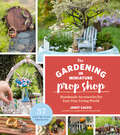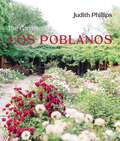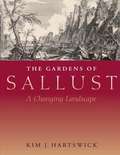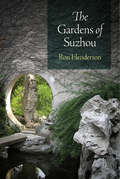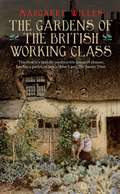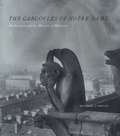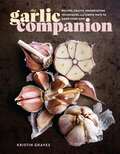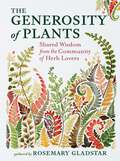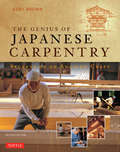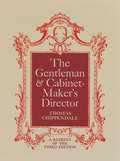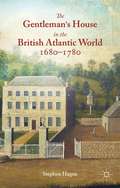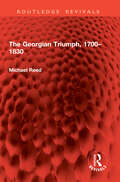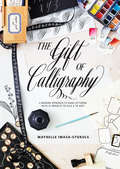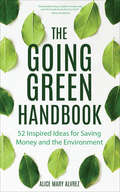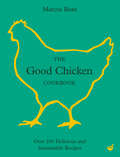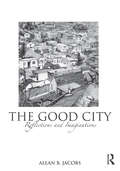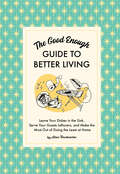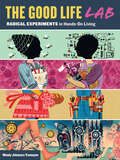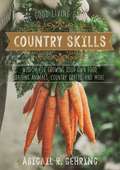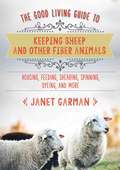- Table View
- List View
The Gardening in Miniature Prop Shop: Handmade Accessories for Your Tiny Living World
by Janit CalvoA not-so-mini trend The Gardening in Miniature Prop Shop is the next big thing for the crafters and gardeners already captivated by gardening small. Organized by playful themes—including gardens around the world, holidays, and fantasy gardens—it’s a fun-filled guide to creating one-of-a-kind gardens and the accessories that make them shine. Thirty-seven projects are included with fully illustrated, step-by-step instructions. For a Japanese garden, you will learn how to create a miniature sand garden. For a Halloween garden, you'll learn how to make a flying ghost and zombie. And for a space garden, you'll learn how to make a tiny space ship and alien. The Gardening in Miniature Prop Shop is for anyone enchanted by the whimsy of creating a tiny world.
The Gardens of Emily Dickinson
by Judith Farr Louise CarterIn this first substantial study of Emily Dickinson's devotion to flowers and gardening, Judith Farr seeks to join both poet and gardener in one creative personality. She casts new light on Dickinson's temperament, her aesthetic sensibility, and her vision of the relationship between art and nature, revealing that the successful gardener's intimate understanding of horticulture helped shape the poet's choice of metaphors for every experience: love and hate, wickedness and virtue, death and immortality. Gardening, Farr demonstrates, was Dickinson's other vocation, more public than the making of poems but analogous and closely related to it. Over a third of Dickinson's poems and nearly half of her letters allude with passionate intensity to her favorite wildflowers, to traditional blooms like the daisy or gentian, and to the exotic gardenias and jasmines of her conservatory. Each flower was assigned specific connotations by the nineteenth century floral dictionaries she knew; thus, Dickinson's association of various flowers with friends, family, and lovers, like the tropes and scenarios presented in her poems, establishes her participation in the literary and painterly culture of her day. A chapter, "Gardening with Emily Dickinson" by Louise Carter, cites family letters and memoirs to conjecture the kinds of flowers contained in the poet's indoor and outdoor gardens. Carter hypothesizes Dickinson's methods of gardening, explaining how one might grow her flowers today. Beautifully illustrated and written with verve, The Gardens of Emily Dickinson will provide pleasure and insight to a wide audience of scholars, admirers of Dickinson's poetry, and garden lovers everywhere.
The Gardens of Los Poblanos (New Century Gardens and Landscapes of the American Southwest)
by Judith PhillipsIn The Gardens of Los Poblanos, landscape designer and garden writer Judith Phillips recounts the history of these world-renowned gardens and demonstrates the ways in which the farm&’s owners, designers, and gardeners have influenced the evolution of this unique landscape. Phillips showcases how the changes in landscape style and content are driven by cultural expectations and climatic realities, and she discusses how the gardens of Los Poblanos have helped preserve the deep agrarian roots of the village of Los Ranchos de Albuquerque. Although plants are always a focus for Phillips, she demonstrates how gardens are more than plants and how plants are much more than mere fillers of garden space.
The Gardens of Sallust: A Changing Landscape
by Kim J. HartswickPleasure gardens, or horti, offered elite citizens of ancient Rome a retreat from the noise and grime of the city, where they could take their leisure and even conduct business amid lovely landscaping, architecture, and sculpture. <P><P>One of the most important and beautiful of these gardens was the horti Sallustiani, originally developed by the Roman historian Sallust at the end of the first century B.C. and later possessed and perfected by a series of Roman emperors. Though now irrevocably altered by two millennia of human history, the Gardens of Sallust endure as a memory of beauty and as a significant archaeological site, where fragments of sculpture and ruins of architecture are still being discovered.
The Gardens of Suzhou (Penn Studies in Landscape Architecture)
by Ron HendersonSuzhou, near Shanghai, is among the great garden cities of the world. The city's masterpieces of classical Chinese garden design, built from the eleventh through the nineteenth centuries, attract thousands of visitors each year and continue to influence international design. In The Gardens of Suzhou, landscape architect and scholar Ron Henderson guides visitors through seventeen of these gardens. The book explores UNESCO world cultural heritage sites such as the Master of the Nets Garden, Humble Administrator's Garden, Lingering Garden, and Garden of the Peaceful Mind, as well as other lesser-known but equally significant gardens in the Suzhou region.Unlike the acclaimed religious and imperial gardens found elsewhere in Asia, Suzhou's gardens were designed by scholars and intellectuals to be domestic spaces that drew upon China's rich visual and literary tradition, embedding cultural references within the landscapes. The elements of the gardens confront the visitor: rocks, trees, and walls are pushed into the foreground to compress and compact space, as if great hands had gathered a mountainous territory of rocky cliffs, forests, and streams, then squeezed it tightly until the entire region would fit into a small city garden.Henderson's commentary opens Suzhou's gardens, with their literary and musical references, to non-Chinese visitors. Drawing on years of intimate experience and study, he combines the history and spatial organization of each garden with personal insights into their rockeries, architecture, plants, and waters. Fully illustrated with newly drawn plans, maps, and original photographs, The Gardens of Suzhou invites visitors, researchers, and designers to pause and observe astonishing works from one of the world's greatest garden design traditions.
The Gardens of the British Working Class
by Margaret WillesThis magnificently illustrated people's history celebrates the extraordinary feats of cultivation by the working class in Britain, even if the land they toiled, planted, and loved was not their own. Spanning more than four centuries, from the earliest records of the laboring classes in the country to today, Margaret Willes's research unearths lush gardens nurtured outside rough workers' cottages and horticultural miracles performed in blackened yards, and reveals the ingenious, sometimes devious, methods employed by determined, obsessive, and eccentric workers to make their drab surroundings bloom. She also explores the stories of the great philanthropic industrialists who provided gardens for their workforces, the fashionable rich stealing the gardening ideas of the poor, alehouse syndicates and fierce rivalries between vegetable growers, flower-fanciers cultivating exotic blooms on their city windowsills, and the rich lore handed down from gardener to gardener through generations. This is a sumptuous record of the myriad ways in which the popular cultivation of plants, vegetables, and flowers has played-and continues to play-an integral role in everyday British life.
The Gargoyles of Notre Dame: Medievalism and the Monsters of Modernity
by Michael CamilleMost of the seven million people who visit the cathedral of Notre Dame in Paris each year probably do not realize that the legendary gargoyles adorning this medieval masterpiece were not constructed until the nineteenth century.
The Gargoyles of Notre-Dame: Medievalism and the Monsters of Modernity
by Michael CamilleMost of the seven million people who visit the cathedral of Notre Dame in Paris each year probably do not realize that the legendary gargoyles adorning this medieval masterpiece were not constructed until the nineteenth century. The first comprehensive history of these world-famous monsters, The Gargoyles of Notre-Dame argues that they transformed the iconic thirteenth-century cathedral into a modern monument. Michael Camille begins his long-awaited study by recounting architect Eugène Viollet-le-Duc’s ambitious restoration of the structure from 1843 to 1864, when the gargoyles were designed, sculpted by the little-known Victor Pyanet, and installed. These gargoyles, Camille contends, were not mere avatars of the Middle Ages, but rather fresh creations—symbolizing an imagined past—whose modernity lay precisely in their nostalgia. He goes on to map the critical reception and many-layered afterlives of these chimeras, notably in the works of such artists and writers as Charles Méryon, Victor Hugo, and photographer Henri Le Secq. Tracing their eventual evolution into icons of high kitsch, Camille ultimately locates the gargoyles’ place in the twentieth-century imagination, exploring interpretations by everyone from Winslow Homer to the Walt Disney Company. Lavishly illustrated with more than three hundred images of its monumental yet whimsical subjects, The Gargoyles of Notre-Dame is a must-read for historians of art and architecture and anyone whose imagination has been sparked by the lovable monsters gazing out over Paris from one of the world’s most renowned vantage points.
The Garlic Companion: Recipes, Crafts, Preservation Techniques, and Simple Ways to Grow Your Own
by Kristin GravesCelebrate all things garlic, with this stunning cookbook featuring 36 garlic-forward recipes, as well as spice mixes, craft ideas, floral arrangements, growing instructions, and inspiration for garlic-themed dinners. In The Garlic Companion, author and garlic devotee Kristin Graves celebrates the wonderful world of this pungent herb, including how to plant, grow, harvest, and preserve it, as well as how to use both the bulbs and the scapes (flowering stems) in decorations and crafts such as garlic braids and wreaths. She has created 36 recipes that focus on using garlic in all its various forms—from Garlic Scape Refrigerator Pickles to Honey Garlic Ribs to Black Garlic Chocolate Chip Cookies—and offers dozens of ideas for celebrating the garlic harvest.
The Generosity of Plants: Shared Wisdom from the Community of Herb Lovers
by Rosemary GladstarRenowned herbalist Rosemary Gladstar presents a beautiful keepsake collection of teachings, reflections, and insights on the plant world and herbal healing, featuring diverse voices from the community of herbal teachers and practitioners. A beloved teacher and leader in the herbal healing world for more than 50 years, Rosemary Gladstar has curated this collection to explore key themes in herbalism, including: *The sacred teachings of the plants *The importance of preserving knowledge of the plants' healing properties and the work of herbal healers *The practices of gardening and gathering herbs in the wild *The power and passion of the herbal community *The rich value of living with gratitude and reverence for the Earth, and a deep connection to the plant world. Many of the quotes are original to this collection, excerpted from Gladstar's private correspondence and conversations. Her narrative voice introduces each theme, and the text is accompanied by stunning photographs and artwork celebrating the beauty and wonder of plants.
The Genius of Japanese Carpentry
by Azby BrownThis new edition of this Azby Brown architecural classic contains a new preface by Brown, fully revised chapters, along 25% new photography and in color for the first time.An extraordinary and ambitious work of architectural reconstruction is underway in twenty-first century Nara. The Genius of Japanese Carpentry is the story of the twelve-hundred-year-old Yakushiji monastery and the dedicated modern-day craftsmen who are working to restore what has been lost to the depredations of time, fire, and warfare.In the eighth century, anonymous carpenters first erected the intricately-designed timber temples and pagodas that compose the Yakushiji Buddhist monastery. Then as today, these buildings were considered marvels of architectural elegance and traditional Japanese craftsmanship. Although the full restoration will not be complete until 2030, one of the main temples, the Picture Hall, has been completely reconstructed, employing the original methods, architectural style, and largely the same woodworking technology as its predecessors. Azby Brown chronicles the Picture Hall's painstaking restoration through photographs, extensive interviews with the carpenters and woodworkers, and original drawings based on the plans of Japanese master carpenter Tsunekazu Nishioka. An inspiring testament to the craftsmen, their dedication to excellence, and their philosophy of work as personal fulfillment, The Genius of Japanese Carpentry offers detailed documentation of this singular project and a moving reminder of the humanity that bridges past and present.
The Gentle Art of Swedish Death Cleaning: How to Free Yourself and Your Family from a Lifetime of Clutter (The Swedish Art of Living & Dying Series)
by Margareta Magnusson*The basis for the wonderfully funny and moving TV series developed by Amy Poehler and Scout Productions* A charming, practical, and unsentimental approach to putting a home in order while reflecting on the tiny joys that make up a long life.In Sweden there is a kind of decluttering called döstädning, dö meaning &“death&” and städning meaning &“cleaning.&” This surprising and invigorating process of clearing out unnecessary belongings can be undertaken at any age or life stage but should be done sooner than later, before others have to do it for you. In The Gentle Art of Swedish Death Cleaning, artist Margareta Magnusson, with Scandinavian humor and wisdom, instructs readers to embrace minimalism. Her radical and joyous method for putting things in order helps families broach sensitive conversations, and makes the process uplifting rather than overwhelming. Margareta suggests which possessions you can easily get rid of (unworn clothes, unwanted presents, more plates than you&’d ever use) and which you might want to keep (photographs, love letters, a few of your children&’s art projects). Digging into her late husband&’s tool shed, and her own secret drawer of vices, Margareta introduces an element of fun to a potentially daunting task. Along the way readers get a glimpse into her life in Sweden, and also become more comfortable with the idea of letting go.
The Gentleman and Cabinet-Maker's Director
by Thomas ChippendaleThomas Chippendale (1718-79) was the most famous and most skilled of England's master cabinet-makers. So synonymous with excellence in design and craftsmanship was he that his name has been given to the most splendid period of English furniture design.In 1774, Chippendale issued a catalogue of all his designs, a magnificent compilation of 160 engraved plates representing the prevailing furniture styles, particularly the French (Louis XXV), Gothic, and Chinese-manner pieces for which he was best known. The Gentleman and Cabinet-Maker's Director, the most important and thorough catalogue of furniture designs that had ever been published in England, was enormously influential, spreading quickly throughout the Continent and the colonies and guiding the style and construction of furniture everywhere. A second edition was formed the following year, and a third in 1762. Today this classic collection is a very rare and highly valued work.This volume is an unaltered and unabridged republication of the 1762 edition of The Gentleman and Cabinet-Maker's Director. The articles of furniture depicted are extremely varied: chairs, sofas, canopy and dome beds, window cornices, breakfast tables, shaving tables, commodes, chamber organs, cabinets, candle stands, cisterns, chimney pieces, picture frames, frets, and other decorations. The plates contain elegant drawings that show the unique combination of solidity of construction and lightness and grace that was the Chippendale trademark, along with many construction diagrams, elevations, and enlargements of moldings and other details. In addition to the plates, this volume also includes a supplement of photographs of sixteenth-century Chippendale-style pieces, including some executed by Chippendale, complete captions to the photos, and a short biographical sketch of Chippendale by N. I. Bienenstock, editor of Furniture World.The Gentleman and Cabinet-Maker's Director is an indispensable guide for antiquarians, furniture dealers, and collectors, and a treasury of ideas for today's designers. Art lovers and other readers will also find it a delightful browsing book.
The Gentleman’s House in the British Atlantic World 1680–1780
by Stephen HagueThe eighteenth-century Georgian mansion holds a fascination in both Britain and America. Between the late seventeenth century and 1780, compact classical houses developed as a distinct architectural type. From small country estates to provincial towns and their outskirts, 'gentlemen's houses' proliferated in Britain and its American colonies. The Gentleman's House analyses the evolution of these houses and their owners to tell a story about incremental social change in the British Atlantic world. It challenges accounts of the newly wealthy buying large estates and overspending on houses and materials goods. Instead, gentlemen's houses offer a new interpretation of social mobility characterized by measured growth and demonstrate that colonial Americans and provincial Britons made similar house building and furnishing choices to confirm their status inBritish society. This book is essential reading for social, cultural, and architectural historians, curators, and historic house-enthusiasts.
The Georgian Triumph, 1700–1830 (Routledge Revivals)
by Michael ReedIn The Georgian Triumph, 1700–1830 (originally published in 1983), Michael Reed re-creates the ambience of eighteenth-century Britain, a period of astonishing change and, paradoxically, of massive stability. Both the change and the stability were reflected in the landscape.Dr Reed explores the visual impact on the landscape of the adoption of new ideas and practices. These range from the acceptance of the Palladian style of architecture and its gradual replacement by a taste for Gothic, Picturesque or Chinese designs, to the practical exploration of the power of atmospheric pressure and improvements in road-making techniques and the design of water wheels. He describes the ‘feel’ of what it must have been like to live through the years which saw the beginning of the end for the old, medieval society, and the birth of a modern industrial nation. Traditional ways of life were slowly abandoned as ancient open fields were enclosed and divided up by straight roads and hedgerows. Changes in the moral climate led to the gradual disappearance of village feasts and the suppression of cockfighting and bull-running, while other, more acceptable, pastimes such as horse-racing and cricket acquired rules and institutions.The book shows that these changes were brought about by people at work and at play; going about their everyday affairs, they wrote and re-wrote upon the landscape the autobiography of the society of which they formed a part, reflecting its aspirations, ideals and achievements.
The Get Organized Answer Book
by Jamie NovakThe Get Organized Answer Book is an organizing expert's guide to winning the battle with clutter - for good.
The Gift of Calligraphy: A Modern Approach to Hand Lettering with 25 Projects to Give and to Keep
by Maybelle Imasa-StukulsAn easy-to-follow guide to learning the art of calligraphy, with 25 gorgeously photographed projects that use calligraphy to make beautiful gifts and home décor.Calligraphy and hand lettering have surged in popularity as people rediscover traditional handicrafts as a creative outlet and way to relax. Unlike other hand lettering books, The Gift of Calligraphy shows you how to use your calligraphy skills to create invitations, wall art, wrapping paper, a tote bag, even a calligraphy kit for kids. Maybelle Imasa-Stukuls, calligraphy teacher and author of Belle Calligraphy, brings her signature modern style to this traditional craft. The first quarter of the book provides a primer for creating a simple alphabet and how to find your own personal style of lettering, followed by wonderful projects that will delight your family, impress your friends, and beautify your home, all accompanied by clear step-by-step photography and inspiring shots of the finished pieces.
The Going Green Handbook: 52 Inspired Ideas for Saving Money and the Environment
by Alice Mary AlvrezEasy, healthy, money-saving DIY ideas for a sustainable lifestyle Inspired living for the environment: Make your footprint planet-positive. With the gentle guidance of eco-expert, Alice Mary Alvrez, you can start with baby steps and progress to living the green good life! Level up your eco-knowledge with these 52 creative ideas and easy ways to reduce your waste, eat organic, and keep toxins out of your home. Grow organic, reduce waste, live toxin-free, and save money: Inside this helpful and hopeful guide, you'll find tips for greening up all the areas of your life. Learn surprising facts about your impact on the environment and change your habits with do-it-yourself ideas. Start with small, simple changes and work your way up to raising chickens, planting a bee-friendly garden, and growing organic veggies instead of a high maintenance grass lawn. Also find easy composting tips and recipes for toxin-free homemade eco cleansers and paint. A DIY handbook for all levels: Whether you want to be a green rookie or an eco-master, you can help the planet every week of the year. The Going Green Handbook is an inspiring and instructive guide to living the handmade life by consuming less and creating more. Use little, live big! Readers will learn: why we live the way we do and how we can become less wasteful and greener tips, tricks and secrets for a self-sufficient sustainable home and lifestyle starter garden tips for growing your own healthy food, fruit, veggies, and fresh herbs how to save money by going green Save money, be inspired, and go green with this helpful and easy handbook!
The Good Chicken Cookbook: Over 100 Delicious and Sustainable Recipes
by Marcus BeanThis is the go-to cookbook for sustainable chicken recipes, with advice on using the whole bird, preparation techniques and tips on chicken care.Chicken is a superb meat. Tender and full of flavour, it is fantastically versatile, as well as a cheaper and healthier alternative to pork, beef and lamb. However, because of its budget-friendly price tag, it has also become associated with the worst in modern farming: poor conditions, chickens being injected with salt-water and antibiotics, and meat contaminated with salmonella.But it doesn&’t have to be like this. This cookbook reclaims chicken, showing how it can be incorporated into good, sustainable cooking. Marcus Bean, a farm-based TV chef and presenter, has made it his mission to take a fresh look at the chicken, from coop to kitchen.Marcus gives you innovative and inspiring dishes that will also help you to reduce your impact on the planet, from lemongrass and thyme Scotch eggs to chicken tostada. To make the book easy to use, it is structured in response to the needs of our daily lives, so you will find a section with quick weekday meals, one with more leisurely recipes for the weekend, as well as a section for celebrations and occasions when you need a showstopper dish. The book includes:Over 100 recipes, many featuring parts of the chicken less familiar in the domestic kitchen, like the liver or skinGuidance on making use of every part of the chickenAdvice on mastering preparation techniques such as jointing and spatchcockingChicken care and rearing wisdomPerfect for the conscious home cook or chicken smallholders, this book is a one-stop shop for delicious and sustainable chicken recipes.
The Good City: Reflections and Imaginations
by Allan B. JacobsCities, Allan B. Jacobs contends, ought to be magnificent, beautiful places to live. They should be places where people can be fulfilled, where they can be what they can be, where there is freedom, love, ideas, excitement, quiet and joy. Cities ought to be the ultimate manifestation of society’s collective achievements. Allan B. Jacobs is one of the world’s best known planners and urban design practitioners, with a long and distinguished international career. Drawing on his professional experience of almost sixty years, Jacobs guides the reader through the lessons he’s learnt as a planner and lover of cities. Cities from Brazil, Italy, India, Japan, China and the US are featured. Written with a wonderfully engaging, humorous tone and Jacobs’ own drawings, The Good City transfers lessons on city design, building and urban change to all those willing to help cities become the magnificent, beautiful places they should be - and encourages all inhabitants to learn to appreciate and explore their own cities.
The Good Enough Guide to Better Living: Leave Your Dishes in the Sink, Serve Your Guests Leftovers, and Make the Most Out of Doing the Least at Home
by Alison ThrockmortonWith an abundance of hilarious household tips, Leave Your Dishes in the Sink is here to teach you how to look like you're doing the most by doing less.Most home economics books share the same guidance: "the best way of doing things." In a world of Instagram-worthy homes and Pinterest-perfect meals, sometimes the best way of doing things feels unattainable. Leave Your Dishes in the Sink teaches you how to work with life’s most relatable habits to create the illusion of upkeep and a façade of cleanliness. Taking you room by room—from the kitchen and the living room to the bedroom and the bathroom—you’ll learn the proper (aka easiest) way of doing things. Avoid dirty dishes by eating out of the jar. Choose the houseplant that will match your level of self-doubt. And who needs folding the laundry when you have The Chair? You’ll even find out how to entertain your guests without them noticing you haven’t vacuumed your carpet since you signed your lease.With the help of elegant charts and diagrams, you’ll find answers to some of the life’s toughest questions, including:How do I fold a fancy napkin? (Just don’t.)Does a bucket count as a cup? (Yes.)Which way does the toilet paper roll go? (Who cares!)Witty and absurd, Leave Your Dishes in the Sink is a hilarious reminder that real life exists and it’s okay to give yourself a break. By doing less, you too can create your dream home—or at least one that’s totally fine just the way it is.The best kind of self-improvement book, this anti-perfectionism guide gives you permission to give yourself a break while getting in some laughs!LAUGH-OUT-LOUD RELATABLE: Author Alison Throckmorton perfectly distills all the universal shortcuts we take as adults trying to keep it all together, like leaving your dishes in the sink "to soak" and using that one chair you have as a second dresser.REAL-WORLD HOUSEHOLD HINTS & TIPS: For anyone exhausted by searching for things that spark joy or the TikToks pushing housecleaning as therapy, this guide offers the perfect mix of parody and empathy. Step over the laundry pile to flip through these delightfully illustrated pages for tips and tricks to finding happiness among the chaos.FUNNY GIFT FOR EVERYBODY: This book makes a great gift for a recent graduate, a friend who just became a homeowner or renter, a new mom, or a parent who has been keeping the house together for thirty years.Perfect for:Anyone who hates doing household chores (everyone)Millennials trying to adultNew renters or homeownersGift-giving for birthday, graduation, Mother’s Day, or Father's DayReaders of Feathered & Fabulous, The Underachiever's Manifesto, and The Subtle Art of Not Giving a F*ck
The Good Housekeeping Household Encyclopedia
by Good HousekeepingHow to manage a household, with a variety of tips and techniques.
The Good Life Lab: Radical Experiments in Hands-On Living
by Dale Dougherty Sandor Ellix Katz Wendy Jehanara Tremayne Christopher Bamford Brad Lancaster Alyce Santoro Pir Zia Inayat-Kahn The Reverend Billy Doug RushkoffTired of the high-pressure life they lead in New York City, Wendy Jehanara Tremayne and her husband migrate to Truth or Consequences, New Mexico, where they build, invent, forage, and grow all they need for themselves. Full of quirky stories and imaginative illustrations, this inspiring memoir chronicles the off-the-grid adventures of the Tremaynes. Touchingly personal while also providing practical tutorials on making your own biofuel, building an efficient house, and gardening sustainably, The Good Life Lab will encourage you to chase your dreams of self-sufficiency.
The Good Living Guide to Country Skills: Wisdom for Growing Your Own Food, Raising Animals, Canning and Fermenting, and More
by Abigail R. GehringGehring’s books on country living have sold more than 500,000 copies. In this book, Gehring offers a guide to country living skills that is as charming as it is practical. Full of sweet illustrations and gorgeous photographs, step-by-step instructions for essential skills such as building a chicken coop are interspersed with country lore and old-fashioned tips and tricks.Readers will learn how to:Raise chickensMake candlesChurn butterGrow vegetablesMake jams and jelliesDry herbsFerment vegetablesMake cheeseAnd more!Good Living Guide to Country Skills combines the know-how of Back to Basics with the charm of The Farmer’s Almanac. Packaged in an attractive hardcover format and with a price that’s hard to beat, this is the perfect gift for anyone interested in a more self-sufficient, greener, country lifestyle.
The Good Living Guide to Keeping Sheep and Other Fiber Animals: Housing, Feeding, Shearing, Spinning, Dyeing, and More
by Janet GarmanA comprehensive and inspiring guide small-scale fiber farming and wool crafting. Fiber crafts—such as knitting, weaving, and crocheting—continue to surge in popularity, with sites like Ravelry (a social media community for the wool obsessed) gaining more than six million members. Artists are seeking quality raw materials in greater numbers. The cottage industry of supplying not only raw fleece, but handcrafted yarns, is strong. Janet Garman has a small fiber flock (including Pygora fiber goats) and shares her expertise, as well as interviews, tips, and advice from fiber farmers and craftspeople across the country. In these pages, readers will learn the basics of properly raising sheep, goats, llamas, alpacas, and rabbits, with tips on selecting animals, feeding, housing, breeding, and healthcare. From there, instructions are provided for shearing, sorting, skirting, washing, picking, carding, combing, and spinning the wool. Enthusiasts will also find recipes and instructions for natural, plant-based dyes and advice for selling your finished yarn. The proper care of fiber animals leads to a superior yarn product. Lapses in good care can show up in the fleece. As the demand for quality yarn and fiber grows, more people are becoming concerned with the animals’ treatment and care. Give your animals a good home and a happy life and enjoy superior fleece and yarn products for your own homestead or to sell.
